Consider this:
“Betty bought a bit of butter. But the butter Betty bought was bitter. So, Betty bought a better butter, and it was better than the butter Betty bought before.”
Now, consider this:
“Betty bought a bit of butter.
But the butter Betty bought was bitter.
So, Betty bought a better butter,
and it was better than the butter Betty bought before.”
Which one do you prefer? The second one is more visually appealing and easy for your eye to catch, right?
This is because the second format of writing is clearer and easily readable, which brings us to content readability – the art and mathematics of making your work easy to digest.
Consequently, the message is delivered better.
The basics- what is readability?
Readability is the marker that helps you determine if your written content is easy to read or not.
But, why would you need to worry about that in the first place?
Picture talking to person A, say, Sara who has an impressive vocabulary. Only, sometimes the words that Sara speaks go over your head, so you find it hard to understand what she says.
On the flip side, imagine conversing with person B, let’s call her Lara, who talks in a simple language. So, you can understand what she says better.
In fact, you can even want to engage in a conversation with Lara. With Sara though, you’ll probably think that your language doesn’t match her standards. So, chances are you will end up sealing your lips and politely smiling until the talk is finally over.

Now, think about reading from a screen. Screen 1 is Sara and screen 2 is Lara. Here you go:
Screen 1:
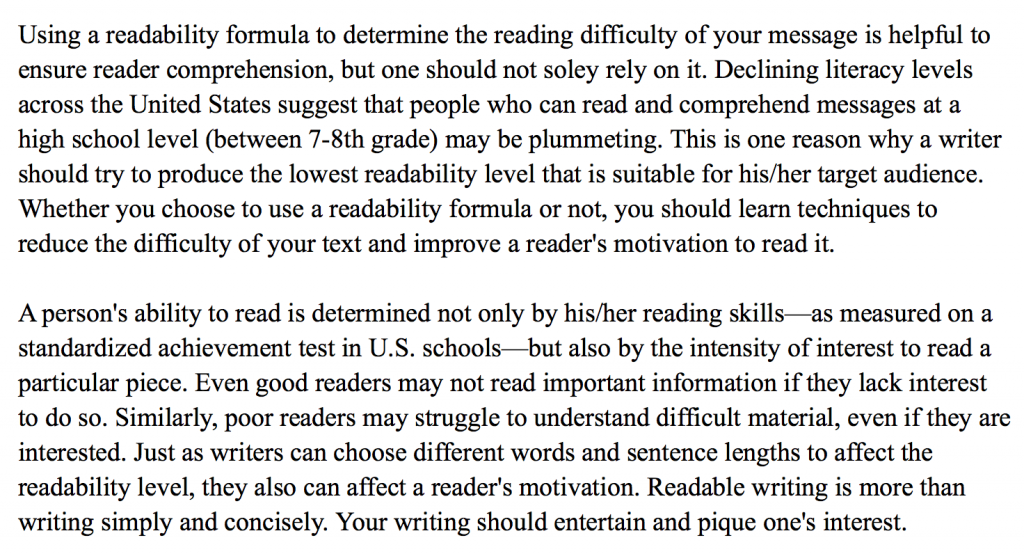
Source – Our supposed Sara
Screen 2:
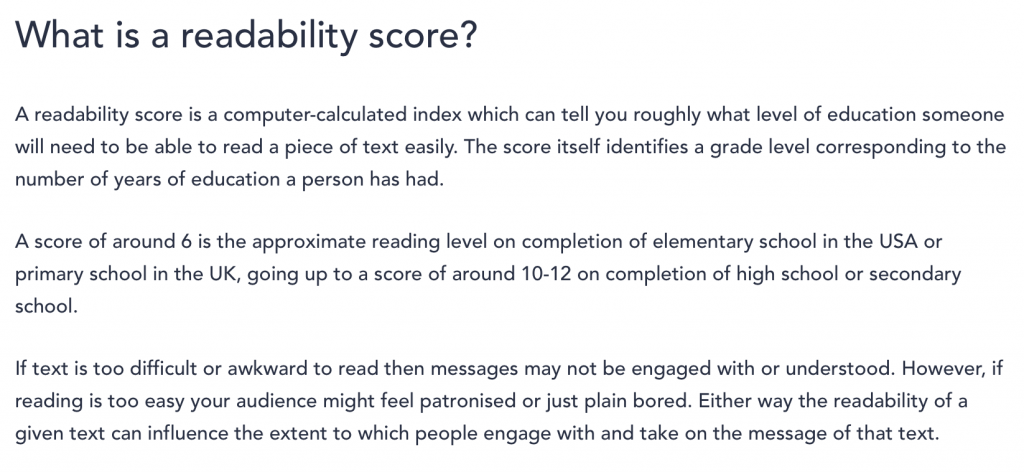
Source – Our supposed Lara
Comprehending screen 2 is better in contrast with screen 1. And, this is what is readability:
• Better text clarity
• Improved understanding of words
• Enhanced engagement of the reader
Mounting research agrees that reading on a screen is harder than paperback reading. Neuroscientists confirm that processing words account for a greater cognitive load on the brain than images.
Fun fact: 92% of the college students are old-fashioned. They prefer reading print books over e-books.
Top that up with declining attention spans and the amount of content on the internet, it gets challenging to attract and retain eyeballs on the message that you want to convey to your audience.
What’s more, lower attention spans translate to lower tolerance for confusion. So, you have to ensure that your write-up is not a jumble of words thrown in without rhyme or reason.
Several factors go into improving your work’s readability. These include the language you use, the vocabulary you choose, the sentence length you finalize, the grammar as well as the paragraph length you keep.
Each step has to be carefully taken– no heavy words, better use of transition words, shorter sentences, small paragraphs, bulleted or numbered lists, and more.
Why does your content need to be readable in the first place?
By now you already know that chatting with Lara is a lot more fun than talking to Sara with her colorful vocabulary.
If you apply this to your e-content, readability will make more sense to you. To cut to the chase, all words in the online sphere are written for better communication.
So, by enhancing your content’s readability, you’re ensuring that you are communicating effectively with your audience. Otherwise, you will miserably fail in getting your point across.
The findings of a 2016 survey of 550 business executives concluded the same. As many as 81% of the respondents agreed that poorly written content wasted a lot of their time.
That’s not the aim that you have in mind, right?
Therefore, you’ll need to pay attention to your content’s readability. In addition to using words as effective tools of communication, there are other benefits of readability:
1. Easily scannable and clear content gets you more readers
You need to keep in mind two crucial statistics:
• Readers only read 20% of the text on an average page
• 55% of the people read a blog post for 15 seconds or less
Pair these figures with shorter attention spans and the problem of getting readers grows. Former CEO of Chartbeat, a content intelligence company, Tony Haile paints a clearer picture.
He points out,
“We are getting a lot wrong about the web these days. We confuse what people have clicked on for what they’ve read. We mistake sharing for reading.”
Fortunately, readability can get you some eyeballs. By improving your content’s readability, you attempt to take all the attention-grabbing steps to encourage people to read more of your content.
Also, readability helps leave a positive impression on your reader’s mind within the 15 seconds they give to reading your blog.
2. Good for your SEO game
Search engine optimization gets your website better rankings in the browsers. And guess who’s joining the party as a chief guest – readability!
Suppose users visit your site but leave almost instantly because they find nothing attractive. This reduces the amount of time users spend on your website or to be accurate shortens their dwell time.
Google is quick to pick these exit and bounce rates, which negatively affects your search engine ranking. Of course, there’s more to gaining your viewers’ attention than writing succinctly and clearly. Design, a buggy backend, font, and other factors play a significant role besides readability. However, this write-up talks mainly about the ‘R’ word.
In simple words, readable websites are likely to rank high in the browsers. Users return to the site because they find your content easy to understand and the site feels accessible.
3. Improved traffic and better engagement
When your content is more readable, it is more useful to your audience. This means that they will come back for more, which increases your traffic.
In contrast, complicated jargon or phrases confuse your readers, which is why they leave your page, never to return again.

The key is to remember that your site visitors are real people, so use their language and be conversational.
As your content’s readability score goes up, the content’s usability rate also increases. This helps improve engagement and conversion as well. So, in short:
Better readability = higher usability rate = improved traffic + engagement and conversions.
4. Better conversions
Improved content readability boosts conversions too. By writing readable blog posts for your website you are, essentially, striving to develop relationships with your target audience by helping solve their problems.
Eventually, your readers understand that you come from a position of authority. Multiple things happen – they resonate with your values, you convince them with your words, they see you as someone who understands them and so on.
Consequently, conversions improve. However, it all begins with gaining your site visitors’ attention by presenting them clear, complication-free, readable content.
Let’s talk the talk now – How to improve your content’s readability?
When we began our discussion on readability, we called it an art and mathematics, and here is where things get complicated.
You don’t need to be at sixes and sevens though. Here’s a simple take on how to
improve your content’s readability:
The mathematical part: Readability score
We’ve established scores to determine how well we do in different areas, much like a child measuring his height by marking the wall.
A readability score is a computer-calculated marker that gives a rough idea of the level of education of your audience. The number allots a grade-level correlating to the level of education that the target has.
A score of 6 denotes an audience that has completed primary school in the UK and elementary school in the US.
The score can go up to 10-12 to highlight that the reader has completed secondary school or high school.
Basically, readability scores have emerged from readability formulas. A popular one among these is the Flesch Reading Ease Score.
The formula gives you a score based on the sentence and word length in your text. As per this scale, the higher the score, the more readable your content is. A lower score on this scale means that your text is not easy to digest for the reader.
It works to determine your readability like this:

The scores are determined via the following chart:

Let’s take a couple of examples over here:
The Time magazine has a readability score of 52. Similarly, the Reader’s Digest has a score of 65. Moreover, the Harvard Law Review has a readability score in the low 30s.
Fun fact: The cat sat on the mat has the highest readability score of 116.
Another prominent scale is the Flesch Kincaid Reading Ease score that churns out your score based on the syllables per word, sentences, and total words.
You need to remember: the sentence length holds more importance than word length. So, you need to ensure that your sentence length equals roughly 21 words. Keep a sentence no longer than 25 words.
As per the Flesch Kincaid Reading Ease scale, scores run between 0 and 100. A score of 70-80 is equivalent to a 7th grader, aged 12 years. This means that the content is fairly easy to read.
Another prominent readability test is the Gunning Fog. It estimates the ease of reading of the text by looking at the complexity of words and sentence length.
As per this scale, an index of less than 12 is ideal for a broad audience. At the same time, a score that is less than eight is best for almost universal understanding.
The simple part: Easy ways to improve your readability
In a nutshell, the most prominent of the readability scales have taught us to:
• Use fewer syllables
• Keep sentences short
• Use simple words
• Sentence length > word length
• Only use long words when the audience is familiar with them
We also learned that you need to write as per your audience’s need. For instance, if you are writing for kids, your choice of words, sentence structure, and so on will be different than when you are writing for an audience of Ph.D. professors.
Keeping all this to the fore, let’s walk you through simple ways that you can employ to boost your content’s readability:
1. Use simple words
Complex words complicate matters. Try to employ simple vocabulary to catch your readers’ attention.
2. Shorten sentence length
The sentences that you write should not be longer than 25 words. Ideally, keep it to 21 words in a sentence.
3. Write short paragraphs
Long paragraphs can be boring. A user may instantly leave your page if he sees such formatting. Change your paragraphs after every 3-4 lines.
4. Shorten your words
Favor small words in contrast with longer words. For examples, use ‘near’ instead of ‘proximity.’
5. Write in the active voice
Active voice is clearer to understand than passive voice. Therefore, limit the use of passive voice to 5% or less in the total content.
In this regard, Fergal McGovern, the founder and CEO of Visible Thread, a company that helps improve content clarity explains:
“By shortening sentences and using active voice, you can make even technical subject matter more readable and engaging without any “dumbing down.””
So, instead of ‘The content was written by her” (passive voice) go for, “she wrote the content” (active voice).
6. Use fewer syllables
Only use one- and two-syllable words whenever possible. Employ longer words only when they are widely used and understood.
7. Be conversational
Your audience is human. Therefore, it is best to be conversational in your writing. It’s like Kurt Vonnegut Jr said,
“Here is a lesson in creative writing. First rule: Do not use semicolons. They are transvestite hermaphrodites representing absolutely nothing. All they do is show you’ve been to college.”
So, keep it simple.
8. Use your audience’s language
The vocabulary that you choose and the words that you use differ as per your audience. For example, if you’re writing for retiring seniors who are nearing mental health issues, you won’t write like this:
“ya’ll need to take care of yourselves by maintaining a healthy and active life.”
That’s the language that suits millennials better. For an audience of senior folks, you need to keep it simple and straightforward:
“Exercising is an important part of taking care of your health.”
9. Add subheadings to your text
Nobody appreciates a wall of words. Therefore, divide your content with suitable subheadings.
10. Add visuals to your content
Add reading supplements such as graphs, images, infographics, screenshots, and so on. These improve reading as the human brain processes visuals 60,000 times faster than text.
Here’s how widely images are used in content creation:

11. Use transition words
Include transition words in your text. For example, ‘moreover,’ ‘consequently,’ ‘therefore,’ ‘in addition,’ and so on. These help connect sentences and give a direction to your reader.
12. Use bulleted points
Your content will be far more scannable if it is explained in bulleted points. See for yourself:
Text version:
2 teaspoons of garlic, 2 teaspoons black pepper, 1 chopped onion, 1 teaspoon of salt, 2 eggs, and 2 tablespoons of cooking oil.
Bulleted points version:
• 2 tsp. garlic
• 2 tsp. black pepper
• 1 onion (chopped)
• 1 tsp salt
• 2 eggs
• 2 tbsp. cooking oil
13. Good text design
Lastly, make your content more readable by improving the design. To this end, choose a font that is easily understandable. Add color to your text and contrast the font’s color with the background color.
Similarly, add animated gifts and scrolling text. Use a readable font size. Your font size should be at least 14-16 px.
Best tools to help you improve your readability
By now, you know the mathematics (formulas and scores) and art (tips and tricks) that go into enhancing your content’s readability.
However, by the time you’re done creating some awesome content, whether emails, social media content, or blog posts, should you get to counting your words, sentences, and syllables?

Don’t worry. You’ve some excellent readability tools to your rescue. Let’s discuss three of the best ones here:
1. Hemingway Editor

This app employs the Automated Readability Index to determine the readability of your text. It picks up long sentences, complex sentences, and also offers alternatives for long words. It points out the excess use of adverbs and passive voice too.
2. Readable.io

Readable runs multiple tests including Gunning Fog Index, the Automated Readability Index, and Flesch-Kincaid Grade Level to determine your score.
It shows you the syllable, word, and letter count of your text. Readable can also help with your use of adverbs, nouns, and adjectives.
3. Grammarly
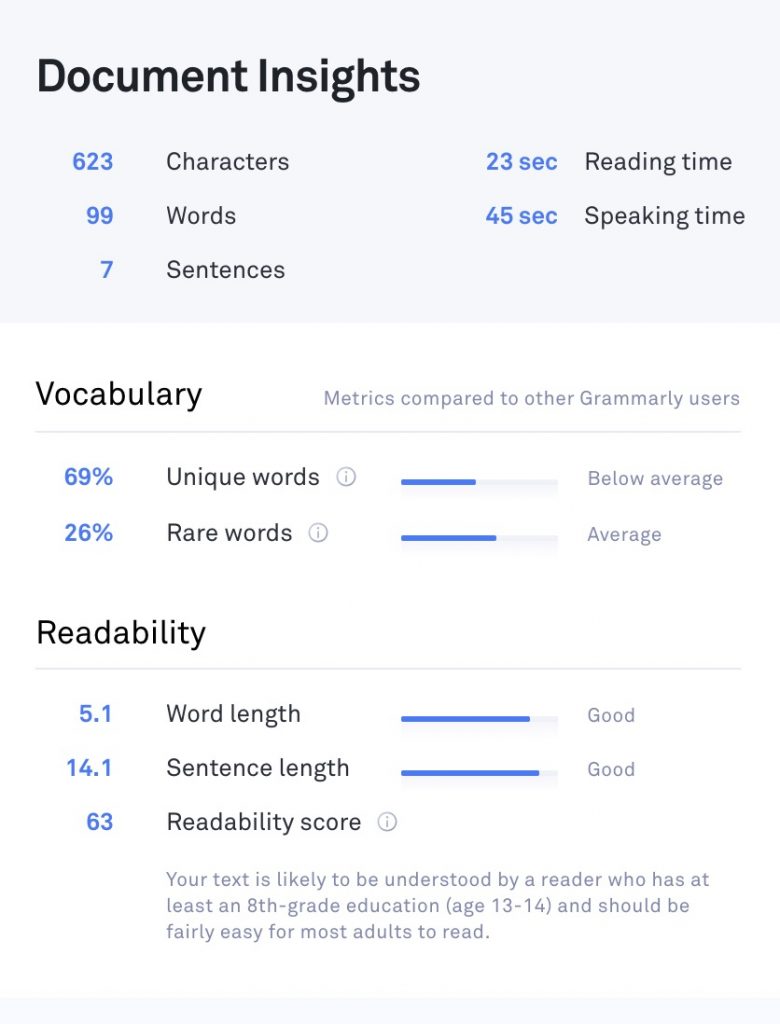
Grammarly is another tool that can help you with improving readability. It gives a picture of how well your content is doing by taking into account the sentence and character length, use of passive voice, reading time, and so on.
You can also check for plagiarism with Grammarly.
Bonus: Yoast SEO
If you are a WordPress user, you just made getting a readability score easier for yourself. At the bottom of every post that you create is a readability detective.
It determines your paragraph and sentence length, assesses passive voice usage, and use of subheadings and transition words. Yoast SEO also helps calculate the Flesch Reading Ease score.
Here’s my readability for the current post:

Wrapping it up – Should you target a readability score?
As a rule of thumb, you should write like you are writing for an eighth grader. Edit out complex words, shorten sentence length, and stick to one- to two-syllable words.
But why should you target an eighth grader? Here’s why:
• Newspapers aim for the readability level of an eighth grader
• The US Department of Education’s National Assessment of Adult Literacy reveals that half of the population has low literacy levels. (The picture is more or less similar worldwide.)
• Boomerang found that emails written for a third grader reading level get the highest response.
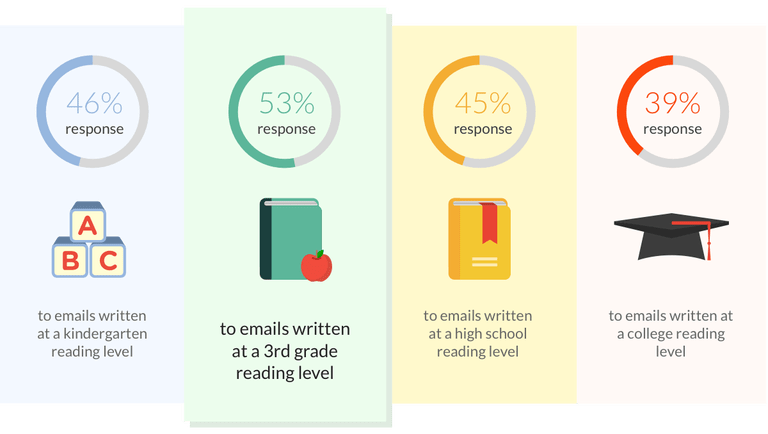
Therefore, it makes sense to write simply and aim for a readability level of an eighth grader. How easy your content is to read matters significantly, impacting your engagement levels, conversion rates, and Google ranking as well.
Conclusively, use shorter sentences, words, and paragraphs. Divide your text with subheadings and add reading supplements to it. Don’t forget to use a conversational style of writing.
If you’re looking for a content writer who can write engaging and clear-to-understand write-ups for you, learn more about my services.
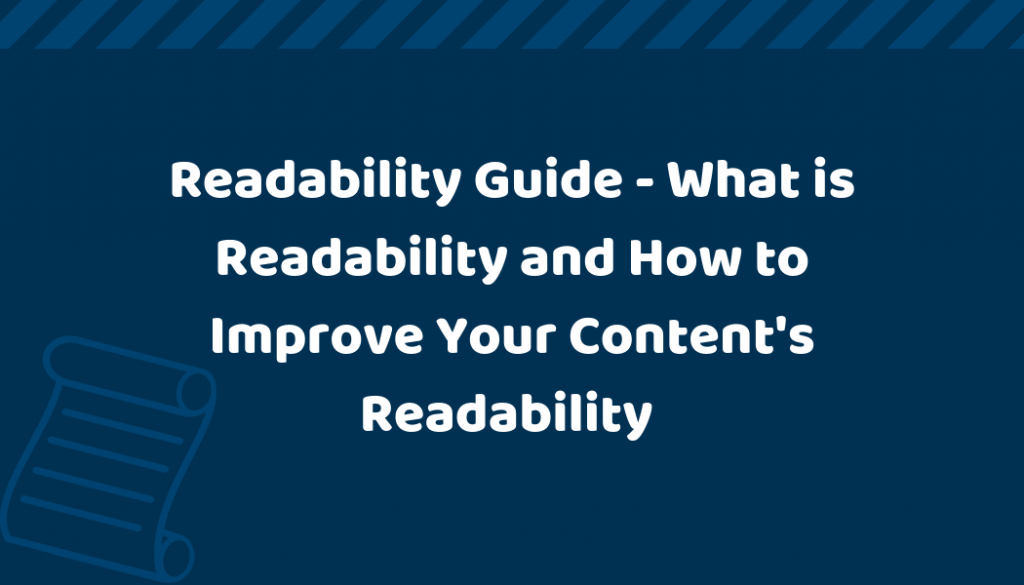
Wow, thanks for the thorough list and tips! I use Yoast but didn’t know about some of the other tools! I can’t wait to reference this when writing my next post!
Thank you, Torey. I’m glad that you found my post helpful. Happy writing. 🙂
The detail in this post is just phenomenal! This is something I wish more people would research as I come across so many blogs where it’s just a wall of text, and it can be difficult to read. Yoast helps me a lot. A lot of my posts start off with a lot of long sentences – which I don’t even realise – so it’s good to have them pointed out for me. Thank you for your insight!
Thank you for your lovely comment, Ruth. I am glad that you found it useful.
This was really helpful! Using active voice and making shorter paragraphs is something I’ll definitely work on.
Thank you, Ivana. Happy writing!
A fantastic resource. thank you!
Many thanks, Liz.
love how detailed your posts always are, and super helpful too! x
Thank you for reading them, Page. 🙂
I wanted to thank you for this good read!! I absolutely loved every bit of it.
I have got you book marked to check out new things you post? https://herbalistoilscbd.net/
I discovered your web site from Google as well as I need to say it was a terrific find.
Many thanks!
An impressive share! I’ve just forwarded this onto a colleague who was conducting a little research
on this. And he in fact bought me dinner simply because I discovered it for him…
lol. So let me reword this…. Thank YOU for the meal!!
But yeah, thanks for spending the time to talk about this issue
here on your blog.
Thanks!
I blog often and I genuinely thank you for your information. Your
article has truly peaked my interest. I am going to take a note of
your site and keep checking for new information about once per week.
I subscribed to your RSS feed as well.
Hi there just wanted to give you a quick heads up. The words
in your post seem to be running off the screen in Safari.
I’m not sure if this is a format issue or something to do with internet browser compatibility
but I figured I’d post to let you know. The design and style
look great though! Hope you get the problem solved soon. Kudos
Sorted. Thanks so much for informing. 🙂
Hey there! I’ve been following your web site for
some time now and finally got the bravery to go
ahead and give you a shout out from Houston Texas! Just wanted to tell you keep
up the excellent work!